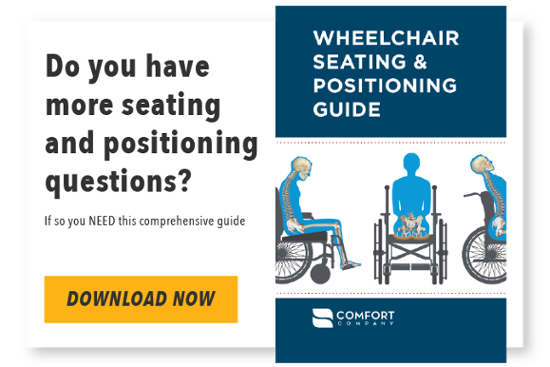Part 2 in our series about Progressive Neurological Disorders. See Part 1.
Working in home health, I saw many clients with progressive neurological disorders. As an OT, my focus was ensuring function and improving the quality of life of my client no matter what stage of the disease. Far too often I saw people stuck with wheelchair seating systems that completely prevented them from functioning independently and significantly decreasing their quality of life instead of enhancing it.
One case comes to mind: Mrs. Smith was a client diagnosed with MS who had been given a group 2 power wheelchair with captain’s seat that was essentially useless for her and sat in her living room collecting dust. She was bed bound because she was unable to maintain an upright position in that chair for more than 30 min. The seating components of a group 2 couldn’t be changed to provide the support and stability that she so desperately needed to sit up in the chair and function.
I was faced with the uphill battle of trying to convince the payors to upgrade her to a group 3 chair with rehab seating. I knew this was going to be tough because her diagnosis hadn’t changed but I had to convince the payors that she had a significant change in function. Unfortunately, when I compared Mrs. Smith’s function and scores from my evaluation to the original, they were far too similar - AND THAT WAS THE BIG PROBLEM.
I’m sure the therapist who did the initial evaluation had the best intentions. She thought that a group 2 chair was adequate at the time of her initial evaluation since Mrs. Smith could sit upright in the chair and manage the joystick. The problem is the therapist didn’t think ahead! She didn’t consider the progressive nature of the disease and how the client’s deterioration might affect function in the long run; that the group 2 chair would be useless in the years to come and that getting her the appropriate chair in the future would be nearly impossible.
What she SHOULD have put into consideration was how Mrs. Smith’s ability to perform daily activities from the chair would change over time and that the inevitable progression of the disease would lead to decreased stability, strength, and endurance.
So what are the things we need to think about when we are working with clients with a progressive neurological disorder?
Every diagnosis has its own hallmarks, but most progressive neurological disorders have signs and symptoms in common. By considering each of these areas, we can achieve an optimal wheelchair seating system for our clients:
-
Progressive Weakness
-
Changes in sensation- hyper or hypo
-
Decreased respiration
-
Decreased ability to verbally communicate
Check out my next blog where I’ll discuss the issues to consider with progressive weakness.

Stacey Mullis, OTR/ATP
Director of Clinical Marketing
Stacey is Director of Clinical Marketing. She graduated from Western University in London, Ontario, Canada with a BA Linguistics and BSc Occupational Therapy and has practiced as an OTR for over 20 years. With experience in pediatrics, inpatient/outpatient rehabilitation, long term care, and home health, Stacey has faced the challenges first hand of providing appropriate seating in various clinical settings. This led her to pursue an apprenticeship at Care Partners Seating Clinic in Asheville, NC to advance her skills, and she obtained her ATP certification in 2012. Mullis is a member of the NCOTA, CTF, NRRTs, RESNA, and AOTA.

